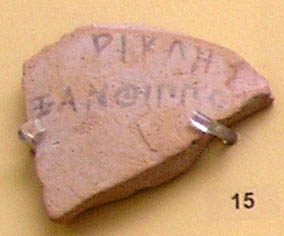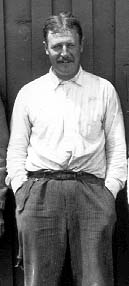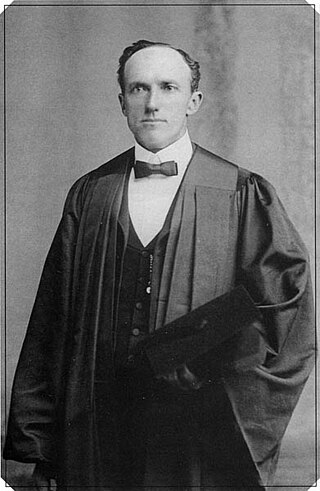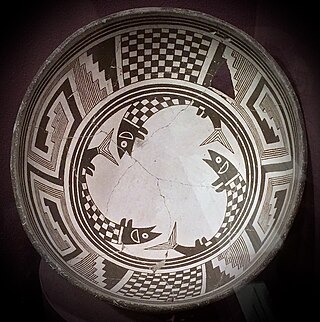
In archaeology, a sherd, or more precisely, potsherd, is commonly a historic or prehistoric fragment of pottery, although the term is occasionally used to refer to fragments of stone and glass vessels, as well.

Nampeyo was a Hopi-Tewa potter who lived on the Hopi Reservation in Arizona. Her Tewa name was also spelled Num-pa-yu, meaning "snake that does not bite". Her name is also cited as "Nung-beh-yong," Tewa for Sand Snake.

Native American pottery is an art form with at least a 7500-year history in the Americas. Pottery is fired ceramics with clay as a component. Ceramics are used for utilitarian cooking vessels, serving and storage vessels, pipes, funerary urns, censers, musical instruments, ceremonial items, masks, toys, sculptures, and a myriad of other art forms.

Alfred Vincent Kidder was an American archaeologist considered the foremost of the southwestern United States and Mesoamerica during the first half of the 20th century. He saw a disciplined system of archaeological techniques as a means to extend the principles of anthropology into the prehistoric past and so was the originator of the first comprehensive, systematic approach to North American archaeology.

Edgar Lee Hewett was an American archaeologist and anthropologist whose focus was the Native American communities of New Mexico and the southwestern United States. He is best known for his role in gaining passage of the Antiquities Act, a pioneering piece of legislation for the conservation movement; as the founder and first director of the Museum of New Mexico; and as the first president of the New Mexico Normal School, now New Mexico Highlands University.
Jesse David Jennings was an American archaeologist and anthropologist and founding director of the Natural History Museum of Utah. Based at the University of Utah, Jennings is best known for his work on desert west prehistory and his excavation of Danger Cave near Utah's Great Salt Lake. Considered an exacting academic scholar and author, he was known for conducting systematic excavations with order and cleanliness.

Betty Jane Meggers was an American archaeologist best known for her work in South America. She was considered influential at the Smithsonian Institution, where she was long associated in research, and she wrote extensively about environmental determinism as a shaper of human cultures.
Ceramic petrography is a laboratory-based scientific archaeological technique that examines the mineralogical and microstructural composition of ceramics and other inorganic materials under the polarised light microscope in order to interpret aspects of the provenance and technology of artefacts.

Mississippian culture pottery is the ceramic tradition of the Mississippian culture found as artifacts in archaeological sites in the American Midwest and Southeast. It is often characterized by the adoption and use of riverine shell-tempering agents in the clay paste. Shell tempering is one of the hallmarks of Mississippian cultural practices. Analysis of local differences in materials, techniques, forms, and designs is a primary means for archaeologists to learn about the lifeways, religious practices, trade, and interaction among Mississippian peoples. The value of this pottery on the illegal antiquities market has led to extensive looting of sites.
Mary Butler Lewis (1903–1970) was an American archaeologist, anthropologist, and public educator best known for her contributions to the fields of Mesoamerican archaeology and Northeastern and Central U.S. prehistory. She was the first female archaeologist to earn a doctorate degree from the Department of Anthropology at the University of Pennsylvania, as well as one of the first female archaeologists to earn a Ph.D. in the United States. She worked with the University of Pennsylvania Museum as the Assistant of the American Section and as a Research Assistant, where she conducted her own fieldwork in Piedras Negras in Guatemala. She pioneered research on Mesoamerican pottery and ceramics, which paved the way for many new projects. President of the Philadelphia Anthropological Society, Butler conducted historical research in Pennsylvania and New York.

Rick Dillingham (1952–1994) was an American ceramic artist, scholar, collector and museum professional best known for his broken pot technique and scholarly publications on Pueblo pottery.
Linda Sue Cordell was an American archaeologist and anthropologist. She was a leading researcher of the archaeology of the Southwest United States and Ancestral Pueblo communities. She authored a number of notable books familiar to both the general public and scholars, including the Prehistory of the Southwest. Cordell was well recognized for her mentorship and leadership in the field; she received many awards and honors throughout her career, including being elected to the National Academies of Sciences and the American Academy of Arts and Sciences, and an endowed Peabody Award was named in honor of her in 2014.

Earl Halstead Morris, known as Earl Morris or Earl H. Morris, was an American archeologist known for his contributions to Southwest archaeology. He is also believed to have partially inspired the fictional Indiana Jones of George Lucas' popular Indiana Jones film series. He was born on October 24, 1889 in New Mexico, grew up near what became the Aztec Ruins National Monument, and died on June 24, 1956 in Boulder, Colorado. Morris was buried in Aztec, New Mexico.
The Huber Site (11Ck-1) is located on Tinley Creek 2 miles west of Blue Island in Cook County, Illinois, near the city of Chicago. It is classified as a late prehistoric site with Upper Mississippian affiliation.
The Hoxie Farm site (11Ck-4) is located on Thorn Creek in Thornton, Illinois Cook County Forest Preserve in Cook County, Illinois, near the city of Chicago. It is classified as a late prehistoric to Protohistoric/Early Historic site with Upper Mississippian Huber affiliation.
The Oak Forest Site (11Ck-53) is located in Oak Forest, Cook County, Illinois, near the city of Chicago. It is classified as a late prehistoric to Protohistoric/Early Historic site with Upper Mississippian Huber affiliation.
The Anker Site (11Ck-21) is located on the Little Calumet River near Chicago, Illinois. It is classified as a late prehistoric site with Upper Mississippian Huber affiliation.
Carol Kramer was an American archaeologist known for conducting ethnoarchaeology research in the Middle East and South Asia. Kramer also advocated for women in anthropology and archaeology, receiving the Squeaky Wheel Award from the Committee on the Status of Women in Anthropology in 1999. Kramer co-wrote Ethnoarchaeology in Action (2001) with Nicolas David, the first comprehensive text on ethnoarchaeology, and received the Award for Excellence in Archaeological Analysis posthumously in 2003.
Valentine Roux is a French archaeologist specialising in ceramic production in the Levant between the 5th and 2nd millennium BCE with the aim of identifying the "evolutionary trajectories of ceramic traditions."

Pueblo pottery are ceramic objects made by the indigenous Pueblo people and their antecedents, the Ancestral Puebloans and Mogollon cultures in the Southwestern United States and Northern Mexico. For centuries, pottery has been central to pueblo life as a feature of ceremonial and utilitarian usage. The clay is locally sourced, most frequently handmade, and fired traditionally in an earthen pit. These items take the form of storage jars, canteens, serving bowls, seed jars, and ladles, serving the needs of daily life. Some utility wares were undecorated except from simple corrugations or marks made with a stick or fingernail, however many examples for centuries were painted with abstract or representational motifs. Some pueblos made effigy vessels, fetishes or figurines such as Cochiti Pueblo. During modern times, pueblo pottery was produced specifically as an art form to serve an economic function. This role is not dissimilar to prehistoric times when pottery was traded throughout the Southwest, and in historic times after contact with the Spanish colonialists.











